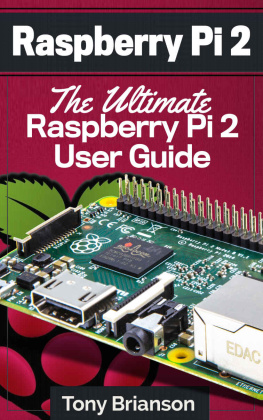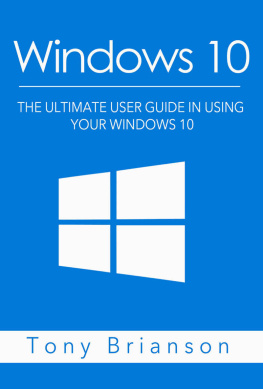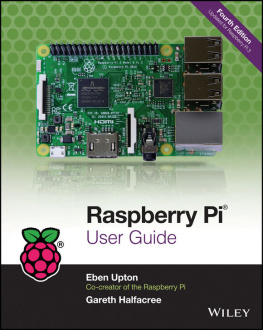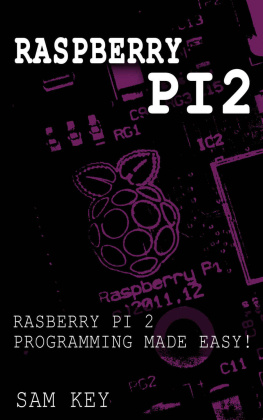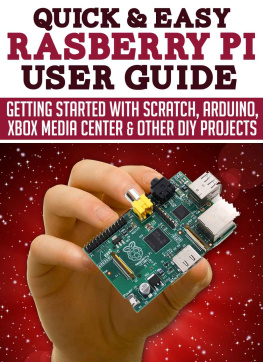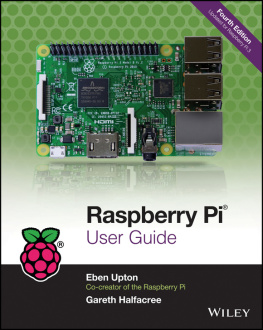Raspberry Pi 2
The Ultimate Raspberry Pi 2 User Guide
By Tony Brianson
This extremely helpful E-Book ( USUALLY PRICED $13.90 ) will walk you through 15 of the best ways to use the famous application Evernote.
I will be giving you this incredible eBook for FREE as a thank you for purchasing this book.

GO TO THE LINK AT THE BACK OF THE BOOK TO CLAIM YOUR FREE GIFT!
Copyright 2015 - All Rights Reserved Tony Brianson
ALL RIGHTS RESERVED. No part of this publication may be reproduced or transmitted in any form whatsoever, electronic, or mechanical, including photocopying, recording, or by any informational storage or retrieval system without express written, dated and signed permission from the author.
Table of Contents
Chapter 1: Introduction To Raspberry Pi
When the first Raspberry Pi model A was released, the intention was to help improve computer science education in high schools. The first model was designed specifically for that purpose.
4 computer scientists observed that the primary school and high school student were not getting proper preliminary introduction into computers. This meant that students graduated from high school without the requisite knowledge to take computer science or related courses, when they got to University. However, interest in the device started growing. According to a BBC News report, there were 5 million devices that had been bought by February 2015.
Despite the fact that the original Pi 1 model A was almost exclusively designed to teach computer science, many people found other applications for the device. Most people have used the device to create a wide range of projects: The project range from IoT (Internet of Things), to home entertainment and video streaming systems.
There are a number of models that came thereafter. These models include A, A+, B and B+. The Pi 2 is the latest model. It is a lot more powerful than the previous Pi 1 models. It was created to provide superior performance on a single board, thanks to the growing list of enthusiasts, who are looking to come up with more sophisticated projects and applications.
The Pi 2 therefore addresses the demand for opportunities for programming and processing speed for 5 million Raspberry Pis owners. It performs exceptionally well and better than any of its predecessor. It was clearly designed to make it possible to work on modern day and future applications like media streaming and the Internet of Things projects.
The Pi 2 was very well received by enthusiasts of this miniature computer. More than 500,000 pieces of the latest Raspberry Pi 2 have already been bought. The high number devices that flew off the shelf is a vote of confidence in the capability and reputation of the last device, as well as all the previous ones.
Some of the things that are uniquely different with the Raspberry 2 are: A new more powerful processor, more on board RAM, higher number of GPIO pins, extra USB slots and an overall better performance. It is definitely the best single board computer that has been released to date.
It is important to make a point of reading this book. It will help you to implement the projects more seamlessly. You will have a deeper understanding and you can decide for yourself why you need the latest Raspberry Pi 2.Whether youre learning the Raspberry Pi 2, using it for education purposes or are just an enthusiast, you can make the most of it by using information available on this book.
Developing games or doing a range projects is not that complicated. However, you need to understand a few of the technical aspects of setting up and successfully executing the technical aspects of the Raspberry. This book aims to provide all the information needed. It is suitable for beginners and also useful for enthusiasts, who want to gain a deeper understanding of the device.
The Evolution of Raspberry Pi 2
The First Raspberry Pi had a 700 Megahertz chip. The chip was a single core with chips very similar to the modern day cell phone. Even though this processor may not seem powerful, it was similar in power to the computers that were commonplace in the late 90s.
Raspberry Pi 2 has a processor chip that is more powerful than all the Pi 1 models including the B+ model, which preceded it. The latest processor is a BCM2836 900 megahertz chip. It is a quad-core chip, unlike all the models that preceded it which were single core.
The other main difference is the memory. The Pi 1 models had 512 kilobytes or less of memory. The new device has a 1 GB board memory, which is double the rating of the Pi 1 B+ model, which had a 512 kilobyte RAM.
Despite the differences, the Pi 2 is similar to the previous model in a number of ways. The manufacturers wanted to keep the size, weight and dimension of the original. It is the same credit card size computer but with better features and performance.
There were advantages of maintaining some of the similarities. It was important to maintain backward compatibility with the previous versions. This would make old tutorials useful to those who owned the current version of the Raspberry for the new chip to work.
Major changes could also make the new version completely different. After several tests, the BCM2836 900 megahertz chip was the best version that came up, which addressed all these issues.
Just like the previous models, it doesnt have a heat sink or fan. It does not need cooling, unless it is over clocked. Many of the input features remained the same, with only a few modifications to improve performance. Therefore, if you had any of the previous models, getting started with the Pi 2 is going to be much easier.
The Unique Features:
The following is a summary of the unique features of the Pi 2:
- 14 HDMI video resolution that ranges from 650x350 to 1920x1200.
- BCM2836 quad-core processor running on a 900 Megahertz system.
- 1 GB on board memory for bigger and better applications.
- 40 Pin GPIO to expand.
- Similar layout and Foot print to model B+.
- The only model with A 10/100 Ethernet port for internet connectivity.
- 4 USB ports that can support a number of demanding devices.
- Switching regulators to help conserve power.
Model A
This was the first version of the Raspberry Pi. The main purpose of this model was to create something that would facilitate learning of computer science. The latest Raspberry has a few similarities. It was designed to weigh, and have dimensions that are about the same as the original.
The main difference is the GPIO pins. Raspberry Pi 1 A had eight pins, while the latest Pi 2 has 5 times that number of 40 pins. The audio and video input on the latest Raspberry Pi 2 has also been changed significantly.
Model A+
This model was designed to be a low cost version of the original model A. It is smaller and weighs less than any other model of the Raspberry. It is also the cheapest version up to date, cheaper than the original model A. The form factor was smaller and neater. It had only one USB port, compared to the current Pi 2s 4 USB port. However, some improvements were made on the earlier version, for example the push mechanism for the USB port was easier and more convenient to use.
Model B
Added features were 2 USB ports unlike 1 on the A+. GPIO grew to 40 pins from 26, which is the same as the current Pi 2 model. It has low noise power supply, and has a number of similarities to the Pi 2. It has an Ethernet capability, the same number of GPIO pins as Pi 2, and also weighs the same as the latest Raspberry model.
Next page
